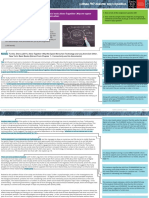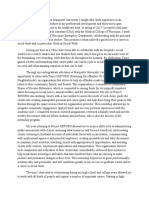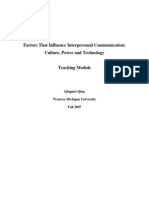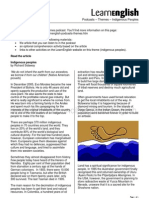Essay - Indigenous People Struggles in Modern Societies.
Uploaded by
Luis VillarEssay - Indigenous People Struggles in Modern Societies.
Uploaded by
Luis Villar54094 Environmental Communication – Spring 2020.
Student: Luis Villar.
Student No. 13475951.
Date: October 26, 2020
Assignment 3: Environmental Communication Project
Essay Topic: Indigenous Futures
October 26, 2020
1
Indigenous People Struggles in Modern Societies.
Through the start of the modern civilisation, indigenous people have become endangered
by modern societies and have struggled through the last three centuries. Overall, indigenous
people have sometimes adapted to modern societies and in other instances, fought them in
many ways. Through the world, indigenous communities have been represented by many as
aggressive, not-modernised and unruly; this representation has brought us today to the very
well documented but still unknown topic of indigenous struggles in the 21st century. To
start, inside the history of connection with aboriginal people and white people, we can see
that many factors that happened around two hundred years ago haven't changed, many
issues even though represented in another manner are still present to this day and have
made it difficult for society to accept indigenous communities and people. In this essay, I'll
analyse indigenous people's history since the modernisation of the world and the effects it
has had on indigenous communities. Also, I'll dive into the way indigenous communities
around the world have reacted to colonisation and how it affects the future of indigenous
people. In general, this paper will reflect on societies influence over aboriginal
communities within many parts of the world and will try to form a dialogue and reach an
agreement on why indigenous people population has been incredibly decreasing through
the current eras concerning the overall world population that keeps on rising by the
moment.
Indigenous people represent one of the most significant populations around the world up to
this day, with the latest recording being in 2013 of around 370 million indigenous people
around the world, but even though indigenous people represent a significant part of the
population, they are still one of the more marginalised groups through the world, and many
live in remote areas where they are frequently the target of resource development (Bodley
2014a, p. 11). Around the world, development and government influence has become one
of the principal dangers to indigenous communities, this types of dangers often come in
governments imposing their presences over indigenous lands, and even though many
indigenous communities through different countries have tried to oppose governments
October 26, 2020
2
control and influence over their territories, it is often shown that these communities that
they lack the power to impose their rights onto the local governments (Bodley 2014b). In
general, indigenous communities attempts to fighting governments intervention over their
lands have been futile, as they are often met with criticism from the general public. For
example, in a fight for indigenous lands in Peru on 2008 the general public saw indigenous
people as the enemy and the police authority as the heroes, in a fight which led to many
deaths the state mourned only the police officers but didn't care for the deaths of indigenous
people (When Two Worlds Collide 2018).
On the other hand, many indigenous communities, instead of fighting, have chosen to flee
to avoid governments influence. Still, this strategy often leaves them scattered and with no
means to continue living with no other option than being incorporated into the
government's power (Bodley 2014b p. 37). A tragic example was that of the Xavante tribe
in Brasil, where the tribe fought against the government until it took the leader of the tribe
to one of the largest cities in Brazil, putting the tribe member in the middle of a stadium
filled with thousands of persons and thus showing him that they hold much more power
than the tribe (Bodley 2014b p. 39). In most scenarios, indigenous communities suffer from
discrimination due to being regarded as less developed than the national majority, as many
of them depend on access to their land for resources when governments start intervening in
this communities with interests for the national majority of the population (Sauer et al.
2018).
Also, many indigenous communities do not want to be contacted. Within Australia, for
example, when Europeans settlers arrived, aboriginal people chose to ignore them until
they became obnoxious (Bodley 2014b, p.36). Furthermore, a study shows that there has
been a significant number of depopulation in tribal communities around the world over the
years in which these communities have been in contact with settlers (Bodley 2014c). But
now that many indigenous people share a place with non-indigenous people, it is surprising
to see how they are still being oppressed, discrimination to aboriginal people has been one
of the most concerning issues within the country, as one of the most seen cases of
October 26, 2020
3
discrimination for Indigenous Australians is seen in the national legal system, as it has been
reported that indigenous Australians are over 14 times more likely to be in prison; it was
also found that indigenous Australians are prone to serve a larger sentence than non-
indigenous Australians for committing the same crime (Anthony 2013, p. 57-58). In
general, even though many indigenous people are adapting to modern society, they still
face discrimination in many parts of the world, from being discriminated by their ethnicity
by many to being seen as a threat. Yet, most importantly, they are discriminated in the
workforce of many countries and are often exploited, facing disadvantages when compared
to non-indigenous people, many of them also because of low job opportunities in their area
have to move to other places to find a job (International Labour Standards Department
2008). Most times, they are not able to find well-paid jobs with most having to work on
informal job sectors where they lack social protection mechanisms (International Labour
Standards Department 2008). More so, in continents like Africa, Indigenous people have a
higher rate of infectious and chronic diseases, as well as a higher rate of mortality and
lower lifespans than non-indigenous people in Africa (Sauer et al. 2018). More so, a study
done in regions of Africa showed that indigenous children have a higher rate of
malnutrition and that these findings do not only apply to indigenous communities within
Africa but also Latin America, Australia and many other parts of the world (Sauer et al.
2018).
Through the world, indigenous people suffer a loss of their political autonomy by the state;
in many cases, indigenous communities have not given this right willingly to the country as
they have defended themselves against large scale societies, many of which in response
have violently clashed with the indigenous communities that seek to reclaim their rights
(Bodley 2014a, p.19). One case of an indigenous community fighting with a state could be
seen in the documentary 'When Two Worlds Collide' which depicts what happened on 2008
in Peru's Amazon rainforest, around that time the Peruvian government wanted to give oil
rights of the amazon to a big corporation that had an interest in Peru's large amount of oil;
through the film, it is seen how this oil concession affected indigenous people land and how
it would affect the livelihood of the community (When Two Worlds Collide 2016). More
October 26, 2020
4
so, the communities response to the government was to organise rallies in the main roads of
the Amazon, in response to this the Peruvian government sent the army to the location and
a clash between indigenous communities and the military occurred, which ended in the
death of many officers as well as indigenous people, through this event indigenous
communities were represented by the media as aggressive and savages, with most of the
Peruvian population supporting the government's actions whilst not taking into
consideration, this event brought a wider divide of hate and discrimination against
indigenous people inside Peru as well as other parts of Latin America (When Two worlds
Collide 2016). This type of event and the response it gets from the mainstream media is not
only exclusive to Latin America, as in Australia, indigenous riots against police brutality
and the deaths of indigenous people in police custody are met with opposing views from
the mainstream media, as it does not focus on the struggles and fights of indigenous people
but only on the police victims, representing indigenous Australians as backward, ignorant
and irrational whilst underlying the deaths in police custody (Anthony 2013, p. 168)
Another reason that indirectly impacts indigenous communities is the worlds rising
population and need for resources that come with it. For instance, in East Pakistan
urbanisation and population growth lead to the destruction of local tribes lands and
displaced around 100, 000 of them, more so, it was later reported by international
organisations that a number of around 185, 000 hill tribes people had been killed because of
the government influence in their lands (Bodley 2014b, p. 27-28). This goes up to show
how even though more than 100 years have passed since colonisers started killing
indigenous communities for their land, not much has changed in the current era and
dispossession, as even though it has changed its ways of how it was 100 years ago, it still
affects aboriginal people in a negative way (Bodley 2014c, p. 48).
The main reason of why coexistence of indigenous communities and present views has
been catastrophic is not only due to the demand many have for their resources, but also to
their different views of the world; for example, in Australia, aboriginal people have
different opinions regarding land, animals and others as they think everything is alive and
October 26, 2020
5
see the beauty in areas which many westerners would think as desolated and lacking life
(Rose 1996, P. 24). These views come to play as well in many other countries, where they
see activities like oil extraction as part of the economy and fail to see the deterrents it
causes to indigenous lands and communities, issues like resource extraction have become
so problematic that many international organisations, including the United Nations, have
expressed their concern over the impacts these activities have on the livelihood of
indigenous communities (Sawyer & Gomez 2012).
In order to achieve coexistence between indigenous communities and nations, it is
important for governments to recognise indigenous identities and territories. In the United
States, even though there are norms in place so that the federal government must consult
native Americans for decisions regarding their lands and resources, in the state of Hawaii,
even though it was stated time and time again that indigenous people would have
sovereignty over their land, the U.S. supreme court has said repeatedly that the federal
government has exclusive power over Indian affairs (Kauanai 2013). Furthermore, many
tribes in America are only recognised by the state they occupy but not by the federal
government, which in many ways supports the rights and relationship with tribal nations;
still, state-recognised tribes lack the immunities that federal tribes posses and have no
sovereign immunity from federal enactments (Koenig & Stein 2013a).In particular,
recognition of indigenous communities is a crucial step to tackle in the fight for indigenous
futures, recognition of indigenous people as their own landowners is important to protect
both the people as well as their environment.
In conclusion, it must be recognised that today's way of living and growing markets have
affected indigenous communities, many of the needs of modern societies have resulted in
the devastations and dispossession of indigenous lands and with it, it has brought negative
impacts towards indigenous communities all around the worlds. Most importantly, it is
necessary to point out that even though society and laws have changed its ways from how
they were 100 years ago, indigenous discrimination and ethnocide, even though in different
ways, it's still present and has evolved into the new century. To counter indigenous
October 26, 2020
6
discrimination and abuse in many parts of the world, governmental organisations need to
recognise and build a special relationship with indigenous communities, also it is important
to control media's recognition of indigenous people as well as they are often portrayed
negatively and these views are able to sway public opinion. Overall, there is still a long way
to go for people to understand and accept indigenous people, land and customs; in general,
it is important for many to join the fight and help indigenous people in their communities or
the ones that still fight for their territories.
Reference List
Anthony, T. 2013, 'Sentencing Indigenous Rioters as if the Racism Never Occurred',
Indigenous People, Crime and Punishment, Routledge, Oxford, pp. 165-191.
Bodley, J. 2014a, 'Introduction: Indigenous Peoples and Culture Scale', Victims of
Progress, 6th edn, Rowman & Littlefield, Lanham, Maryland, pp. 11-21.
Bodley, J. 2014b, 'Progress and Indigenous People', Victims of Progress, 6th edn, Rowman
& Littlefield, Lanham, Maryland, pp. 22-43.
Bodley, J. 2014c, 'The Uncontrolled Frontier', Victims of Progress, 6th edn, Rowman &
Littlefield, Lanham, Maryland, pp. 44-62.
International Labour Standards Department 2008, 'Eliminating Discrimination Against
Indigenous and Tribal Peoples in Employment and Occupation', ILO Convention No. 111,
Geneva, pp 1-7.
Kauanuii. K. 2013, 'Precarious Positions: Native Hawaiians and U.S Federal Recognition',
in A. Den Ouden & J. O'Brien, (Ed.), Recognition, Sovereignty Struggles, and indigenous
Rights in the United States, University of North Carolina Press, Chapel Hill, pp. 311-336.
Koenig, A. & Stein, J. 2013, 'State Recognition of American Indian Tribes: A Survey of
State Recognized Tribes and State Recognition Process', in A. Den Ouden & J. O'Brien,
October 26, 2020
7
(Ed.), Recognition, Sovereignty Struggles, and indigenous Rights in the United States,
University of North Carolina Press, Chapel Hill, pp. 115-146.
Rose, D. 1996. Nourishing Terrains: Australian Aboriginal Views of Landscape and
Wilderness, Australian Heritage Commission.
Sauer, J., Ford, L., Patterson, L., Donnelly, K., Namanya, D., Zavaleta, C., Harper, S. &
Lwasa, S. 2018, 'An Analysis of the Nutrition Status of Neighboring Indigenous and non-
Indigenous Populations in Kanungu District, Southwestern Uganda: Close Proximity,
Distant Health Realities', Social Science & Medicine, vol. 217, pp. 55-64.
Sawyer, S. & Gomez, E. 2012, 'Transnational Governmentality in the Context of Resource
Extraction', The Politics of Resource Extraction: Indigenous Peoples, Multinational
Corporations and the State, Palgrave Macmillan, United Kingdom, pp. 1-8.
When Two Worlds Collide 2016, Documentary, Yachaywasi Films, United States.
October 26, 2020
8
You might also like
- Case Study (Clinical Reasoning Step 3 - 8)No ratings yetCase Study (Clinical Reasoning Step 3 - 8)7 pages
- A Brieft History The Adventist Church and Religious LibertyNo ratings yetA Brieft History The Adventist Church and Religious Liberty4 pages
- Competition Law: First Abuse of Dominance Case by The Philippine Competition CommissionNo ratings yetCompetition Law: First Abuse of Dominance Case by The Philippine Competition Commission1 page
- The Future of Indigenous Peoples in The Philippines Sources of CohesionNo ratings yetThe Future of Indigenous Peoples in The Philippines Sources of Cohesion23 pages
- General History of Aboriginal and Torres Strait Islander PeoplesNo ratings yetGeneral History of Aboriginal and Torres Strait Islander Peoples14 pages
- ALKAN Health Science, Business & Technology College Health Education Credit Hrs-3No ratings yetALKAN Health Science, Business & Technology College Health Education Credit Hrs-324 pages
- Indigenous Science and Technology in The Philippines: EssonNo ratings yetIndigenous Science and Technology in The Philippines: Esson6 pages
- Narrative Essay On Strength and WeaknessNo ratings yetNarrative Essay On Strength and Weakness2 pages
- Impacts of Colonialization To The Atlantic WorldNo ratings yetImpacts of Colonialization To The Atlantic World5 pages
- Internationalization of Philippine Higher EducationNo ratings yetInternationalization of Philippine Higher Education41 pages
- Bohol Island State University: A. Catch The WordNo ratings yetBohol Island State University: A. Catch The Word5 pages
- Critique Paper: Indigenous People in The Philippines100% (1)Critique Paper: Indigenous People in The Philippines3 pages
- Political Science, History Of: Erkki Berndtson, University of Helsinki, Helsinki, FinlandNo ratings yetPolitical Science, History Of: Erkki Berndtson, University of Helsinki, Helsinki, Finland6 pages
- (1935) Privileged Characters: Teapot Dome Scandal100% (1)(1935) Privileged Characters: Teapot Dome Scandal536 pages
- 4.1 Attachment A - Foreign and Domestic Policy Slideshow 1No ratings yet4.1 Attachment A - Foreign and Domestic Policy Slideshow 115 pages
- Full Western Civilizations Their History Their Culture Volume 2 Eighteenth Edition Joshua Cole PDF All Chapters100% (8)Full Western Civilizations Their History Their Culture Volume 2 Eighteenth Edition Joshua Cole PDF All Chapters70 pages
- William D. Johnston - Slavery in Rhode Island (1894)No ratings yetWilliam D. Johnston - Slavery in Rhode Island (1894)70 pages
- Countering Terrorism and Violent Extremism National Strategy OverviewNo ratings yetCountering Terrorism and Violent Extremism National Strategy Overview6 pages
- Smart Communications, Inc. Code of Business Conduct and EthicsNo ratings yetSmart Communications, Inc. Code of Business Conduct and Ethics6 pages
- President Ibrahim Traoré of Burkina Faso Has Demonstrated Steadfast Dedication To BolsteringNo ratings yetPresident Ibrahim Traoré of Burkina Faso Has Demonstrated Steadfast Dedication To Bolstering5 pages
- GRP-1-IPE-CHPTR-1-Presentation-_20250116_234109_0000No ratings yetGRP-1-IPE-CHPTR-1-Presentation-_20250116_234109_000011 pages
- Certified List of Candidates For Congressional and Local Positions For The May 13, 2013 2013 National, Local and Armm ElectionsNo ratings yetCertified List of Candidates For Congressional and Local Positions For The May 13, 2013 2013 National, Local and Armm Elections2 pages
- International Humanitarian Law (Power Point)100% (1)International Humanitarian Law (Power Point)22 pages
- Jurisprudence For Judges: Why Legal Theory Matters For Social Context EducationNo ratings yetJurisprudence For Judges: Why Legal Theory Matters For Social Context Education47 pages
- FBI Director Comey Was Board Member of HSBC - Clinton Foundation & Drug Cartel Bank of Choice'No ratings yetFBI Director Comey Was Board Member of HSBC - Clinton Foundation & Drug Cartel Bank of Choice'3 pages
- Communitarian Theory and Community Development in The United StatesNo ratings yetCommunitarian Theory and Community Development in The United States9 pages
- Letter to Leadership on Medicaid FINAL VERSION 1No ratings yetLetter to Leadership on Medicaid FINAL VERSION 13 pages

























































































